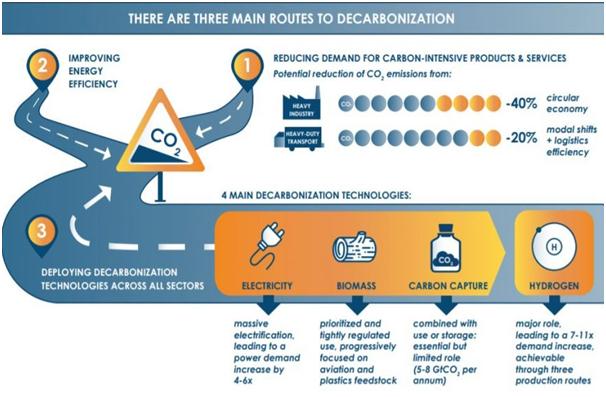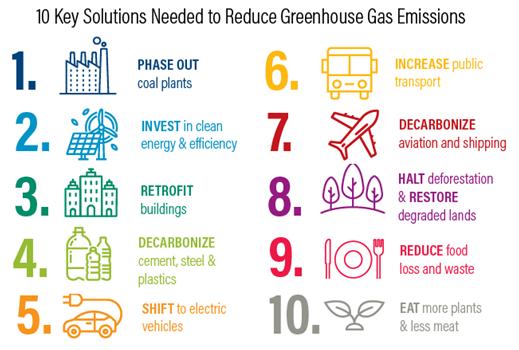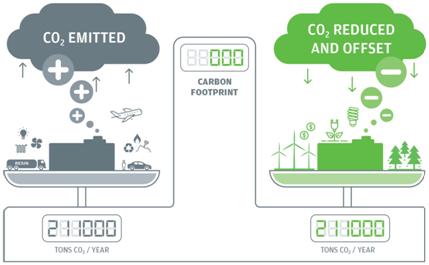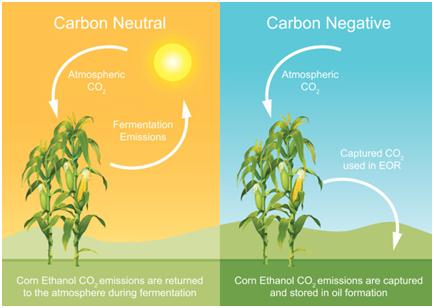Net zero, Carbon neutral, Carbon negative, Carbon positive - The confusing carbon jargons
Countries around the world are taking steps to tackle climate change and become net zero emitters of carbon dioxide by 2050. The most recent Joe Biden’s presidential election win could signify that the United States of Americacould become the latest nation to adopt the goal of becoming net zero carbon dioxideemitter by 2050.
Countries around the world are taking steps to tackle climate change and become net zero emitters of carbon dioxide by 2050. The most recent Joe Biden’s presidential election win could signify that the United States of Americacould become the latest nation to adopt the goal of becoming net zero carbon dioxideemitter by 2050.
Net zero emissions
‘Net zero emissions’ refers to achieving an overall balance between greenhouse gas emissions produced and greenhouse gas emissions taken out of the atmosphere. Therefore, it does not necessarily means completely eliminating all greenhouse gases. The “net” part of net zero means we can still emit carbon dioxide, as long as we offset (or remove) those emissions from the atmosphere by the same amount in other places.
Net zero describes the point in time where humans stop adding to the burden of climate heating gases in the atmosphere. Therefore, in net zero scenarios, emissions are still being generated but they’re offset by the same amount elsewhere. Examples of offset activities include planting trees to absorb carbon dioxide or using other natural ecosystems to increase carbon stored in the biosphere.The concept of net zero emission is similar to “climateneutrality.”
Zero emissions
To understand the term “net zero emissions”, we must also understand what it is not. Zero emissionrefers to a process where no carbon dioxide is released at all. In fact, in our current global mining and manufacturing system, no technology produces zero emissions.
Technologies such as solar panels and wind energy are often said to be zeroemissions but technically, they’re not. They have what are known as “embedded emissions” i.e. those created in manufacturing the technology. However,wind and solar energyproduces no on-going emissions after installation, unlike fossil fuel energy.
Low emissions
Technologies generating greenhouse gases at a lower rate than the normal emissions could be referred to as low emission technologies. Examples include switching from coalfired to gasfired power to generate the same amount of electricity, but with fewer emissions.
TheTimelineneeded to Reach Net Zero Emissions
Under the Paris Agreement, countries had agreed to limit the warming well below 2 degree Celsius and ideally 1.5 degree Celsius. Climate impacts that are already unfolding around the world, even with only 1.1 degree Celsius of warming, range from melting ice to devastating heat waves and more intense storms, andexemplify the urgency of minimizing temperature increase to no more than 1.5 degreeCelsius. The latest reports suggest that to meet the Paris Agreement's temperature goals, the world will need to reach net zero emissions on the following timelines:
- In scenarios that limit the warming to 1.5 degreeCelsius, carbon dioxideemissions could become net zero by 2050 or 2052 depending on the overshootscenario where temperature rise could surpass 1.5 degree Celsius for some time before being brought down. Total greenhouse gasemissions could reach net zero between 2063 and 2068.
- For 2 degree Celsius warming scenario, carbon dioxideemissions could become net zeroby 2070 to 2085 depending on the likelihood of limiting the warming to 2 degree. Total greenhouse gasemissions could reach net zero by the end of the century.
The sooner these emissions peak, and the lower they are at that point, the more realistic it would be to achieve net zero in time. Further, the world would also need to rely less on carbon removal in the second half of the century. The time frame for reaching net zero emissions differs significantly if one is referring to carbon dioxide alone, or referring to all major greenhouse gases(including methane, nitrous oxide, and hydro fluorocarbons). For non-carbon dioxide emissions, the net zero date is later because some of these emissions are comparatively more difficult to phase out,such as, methane emission from agricultural sources. However, these potent but shortlived gases could drive temperatures higher in the nearterm, and push the temperature change above the 1.5 degree Celsius threshold much earlier.
Countries declaring Net zero Targets
A lot of countries are talking about “going net zero” lately. China recently announced it intends to achieve the goal by 2060. Further, France, the United Kingdom and New Zealand have proposed to go net zero by 2050. Similarly, all states and territories in Australia have prepared a net zero strategy and the federal government has been put under pressure to make a national commitment.Correspondingly, it’s not just the countries that could produce net zero emissions; the term could also apply to a state, city, company or even a single building.
Additionally, Austria, Bhutan, Costa Rica, Denmark, the European Union, Fiji, Finland, Hungary, Iceland, Japan, the Marshall Islands, Norway, Portugal, Singapore, Slovenia, Sweden, and Switzerland have committed toadopt net zero targets. Further, more than 120 countries have committed to work on net zero targets through the Climate Ambition Alliance, including all least developed countries and a handful of high emitting countries. However, only around 10% of the global emissions have been covered by some form of adopted net zero targets. Some net zero targets have been incorporated directly into countries' commitments under the Paris Agreement.
Since the countriesvary widely on stages of development and economies, there is no onesizefitsall timeline for individual countries. However, there are hard physical limits to the total emissions the atmosphere can support while limiting global temperature increase to the agreed goals of the Paris Agreement. At the very least, major emitters (such as the United States, the European Union and China) should reach net zerogreenhouse gas emissions by 2050, or it could be hard to control the temperature rise,given that the largest economies play an outsize role in determining the trajectory of global emissions.
Ways to Achieve Net zero Emissions
There needs to be inclusion of major policy, technology and behaviour shifts to achieve Net zero Emissions.For example, in pathways to 1.5 degree Celsius, renewables should supply 70 to 85% of electricity by 2050. Energy efficiency and fuel switching measureswould be critical for transportation. Improving the efficiency of food production, changing dietary choices, halting deforestation, restoring degraded lands, and reducing food waste would also have significant role for emission reduction.
Further,it is critical that the structural and economic transition necessary to limit warming to 1.5 degree Celsius is approached in a just manner, especially for workers tied to high carbon industries. The good news is that most of the technologies needed to reduce emissions are available and they are increasingly becoming cost competitive apart from facilitating alternatives to high carbon. Solar and wind energy sources now provide the cheapest power for 67% of the world. Markets are waking up to these opportunities and to the risks of a high carbon economy, and shifting accordingly.
Additionally, investmentswould be needed to be facilitatedfor carbon removal. Removing carbon dioxide from the atmosphere would be necessary to compensate for emissions from sectors in which reaching zero emissions would be more difficult, such as aviation sector. Carbon removal could be achieved by several means, including land based approaches (such as restoring forests and boosting soil uptake of carbon) and technological approaches (such as direct air capture and storage, or mineralization).
Additionally, there could beother key ways to move to net zero emissions, which are also reflected in most national plans:
- drastically reduce or eliminate the use of fossil fuels in the energy sector (including transport)
- improve efficiency and/or develop new technology in other sectors generating emissions but unable to easily reduce them, such as manufacturing and agriculture
- invest in bio-sequestration (also known as reforestation or treeplanting) and carbonnegative technologies to offset any continuing or unavoidable emissions.
Role of Paris Agreement in Achieving Net zero Emissions
The Paris Agreement has a long term goal of achieving "a balance between anthropogenic emission by sources and removal by sinks of various greenhouse gases in the second half of this century, on the basis of equity, and in the context of sustainable development and efforts to eradicate poverty." The concept of balancing emissions and removals is similar to reaching net zero emissions.
Coupled with the ultimate goal to limit warming well below 2 degree Celsius, and aiming for 1.5 degree Celsius, the Paris Agreement commits governments to sharply reduce emissions and ramp up efforts to reach net zero emissions in time to avoid the worst consequences of climate change. The Paris Agreement framework also invites countries to submit long term, low emissions development strategies by 2020. These strategies could be a medium for setting net zero targets and charting out how countries could aim to make such transitions.
Commitments to create bold short and long term targets that align with a net zero emissions future would send important signals to all the levels of government, to the private sector, and to the public that global leaders are building a safe and prosperous future, rather than one devastated by climate impacts.
Carbon neutral
Carbon Neutral is a term used to describe the state of an entity (such as a company, service, product or event), where the carbon emissions caused by them have been balanced out by funding an equivalent amount of carbon savings elsewhere in the world. The term “carbon neutral” is sometimes used instead of net zero, and broadly they mean the same thing. There are also two specific categories of carbon neutral technologies that are relevant:
- a process that generates carbon dioxide in theshort termanddoes not add to the global warming. An example of this could be bioenergy, where carbon dioxide is initially absorbed by organic material, then released on conversion to energy. Overall, emissions are stable and there is no net increase in carbon dioxide.
- a process that generates carbon dioxide but captures and sequesters (stores) it, rather than releasing it to the atmosphere. An example of this could be a coalfired power plant fitted with carbon capture and storage technology.
Carbon neutrality is often achieved through fundingprojects beneficial toclimate to make up for the greenhouse gases they emit. Such outside projects used as mitigation for greenhouse gas emissions are commonly called “offsets,” since they’re used to offset the emissions of the person or company who buys them.
Roadmap for a Climate Neutral Economy
To meet the goal of achieving a zero carbon footprint, following strategic building blocks could be pursued:
- Energy efficiency: Renovation of the housing sector is critical to boost energy efficiency levelsas they account for a majority of energy consumption.Buildings should meet energy performance standards.
- Deployment of renewables: Besides obvious environmental benefits ofpromoting the development of renewable energies, it would also help boost energy security and domestic employment levels.
- Clean, safe and connected mobility: Transport also accounts for a major portion of greenhouse gas emissions. Curbing this substantial footprint could require prioritizing sustainable urban mobility alternatives, such as public transport or cycling, as well as improving existing vehicles and means of transport, and favouring the use of low or zero emission technologies.
- Competitive industry and circular economy: The industrial production must be modernized in order to curb the greenhouse gas emissions. This includes recycling as a key element to promote an efficient use of resources, especially as regards sectors and technologies which depend on materials whose production is concentrated in a few countries, such as cobalt or graphite.
- Infrastructure and interconnections: Infrastructure is closely related to mobility, due to the need to find synergies at global level to transform the transport sector. This includes the need to build global energy networks.
- Bio economy and natural carbon sinks: Biomass could play a key role in replacing the most polluting materials in heat production applications via the possibility of transforming it into biofuels or biogas.
- Tackle remaining carbon dioxide emissions with capture and storage: there is a need to promote research aimed at improving carbon capture and storage technologies. These technologies, capable of separating, storing and isolating the industry’s carbon emissions, are currently extremely expensive.
Carbon negative and Carbon positive
The reduction of an entity’s carbon footprint to less than neutral, so that the entity has a net effect of removing carbon dioxide from the atmosphere rather than adding it, the entity is called carbonnegative. Carbon Negative sounds bad even though it’s the most altruistic of all sustainability concepts and terms. Becoming carbon negative requires a company, sector or country to remove more carbon dioxide carbon dioxide from the atmosphere than it emits. This means removing carbon dioxidefrom the atmosphere, or sequestering more carbon dioxide than is emitted. This might include a bioenergy process combined with carbon capture and storage.
Carbon Negative and Climate Positive are interchangeable terms.Climate positive?means that an activity goes beyond achieving net zero carbon emissions to actually create an environmental benefit by removing additional carbon dioxide from the atmosphere.The benefit of climate positive initiatives is the spillover benefits they create for other people, companies, or localities that may not have the means or initiative to reduce their own carbon footprints. Ideally, carbon neutrality will become the eventual standard across the board, climate positive initiatives can, in the meantime, help pick up some of the slack.
A ‘carbon positive’ building takes the various strategies a step further by producing more energy than it needs and feeding that energy back into the grid. Carbon positive?moves beyond carbon zero by making additional ‘positive’ or ‘net export’ contributions by producing more energy on site than the building requires and feeding it back to the grid. Carbon positive projects can make significant contributions by helping to address the carbon intensity and damaging impacts of past building practices and lifestyles, and by offsetting situations where carbon zero buildings are not possible.
Carbon Negative Strategies
- Afforestation and reforestation - Afforestation means planting trees where there were previously none. Reforestation means restoring areas where the trees have been cut down or degraded. Because trees take up carbon dioxide from the atmosphere as they grow, planting more trees means boosting how much carbon dioxide forests absorb and store. The UN’s Clean Development Mechanism provides a financial incentive for countries to increase their forest stocks.Estimates suggest that afforestation and reforestation can sequester carbon dioxide at a rate of 7 tonnes per hectare per year, and comes with an associated cost of $20-100 per tonne.
- Biochar - Biochar is produced by burning biomass, such as wood, crop wastes and manurethroughpyrolysis i.e. cutting off the supply of oxygen. The carbon in the resulting biochar is very slow to break down. This means the carbon it absorbed from the atmosphere while it was mere biomass is locked up for hundreds or even thousands of years. A recent study found that biochar has the potential to sequester up to 8 bn tonnes of carbon dioxide equivalent per year. Adding biochar to soils can improve its fertility – acting as a slow-release sponge for water and nutrients – and boost crop yields. The most famous example of this is the Terra Preta (“black earth”) soils in Brazil.Other benefits include biochar being a convenient way of disposing of agricultural wastes, and producing heat and biofuels as by-products during pyrolysis.
- Bioenergy with carbon capture and storage(BECCS) - It is widely viewed as the negative emission technology offering the possibility of drawing significant quantities of carbon dioxide out of the atmosphere at the lowest cost.It achieves net negative emissions through sequestering underground the emissions resulting from the burning of biomass for power.A recent study suggests BECCS could be used to sequester around 12 bn tonnes of carbon dioxide equivalent per year globally.
- ‘Blue carbon’ habitat restoration - Salt marshes, mangroves, and seagrass beds act as natural defences against climate change, capturing carbon dioxide from the atmosphere even faster than terrestrial forests and storing it in their leaves, stems and in the soil. Carbon stored in coastal or marine ecosystems is known as ‘blue carbon’.Conserving and restoring coastal ecosystems so that they can continue to draw carbon dioxide out of the air has been suggested as a way to mitigate climate change.
- Buildings with biomass - Plant-based materials could be used in construction, storing carbon and preserving it for as long as the building remains standing. For example, timber and bamboo could be used for structural elements, hemp and wool for insulation, and hemp-lime for walling.These materials provide an alternative to standard construction materials, including steel and concrete, which are typically carbon-intensive to produce. Natural materials have additional benefits, such as the ability to regulate moisture and absorb pollution.
- Cloud or ocean treatment with alkali - When carbon dioxide dissolves in water it makes carbonic acid, removing carbon dioxide from the air and making the oceans more acidic. Carbon dioxide is not very soluble in water, but the reaction can be enhanced by adding alkali. This provides the inspiration for creating negative carbon dioxide emissions. The current global carbon dioxide emissions could be offset by spraying 56mn tonnes of potassium hydroxide into clouds across 0.4% of the Earth’s surface. Further, large quantities of lime (calcium oxide) added to the ocean. Adding lime to the sea would increase its capacity to absorb carbon dioxide, while also partly offsetting ocean acidification.To remove a billion tonne of carbon dioxide from the atmosphere would require roughly 2.5 bn tonnes of limestone.
- Direct air capture - It means sucking carbon dioxide out of the air. It can then be buried underground or used in chemical processes to make anything from plastic to fuel. The most common approach to capture carbon dioxide from air is to pass air over a special liquid. Carbon dioxide sticks to this mixture while the rest of the air does not. The mixture is then recycled by releasing the carbon dioxide, using heat. Direct capture devices are sometimes likened to artificial trees.Estimates suggest direct air capture could sequester all the carbon dioxide currently emitted each year.
- Enhanced ocean productivity - Marine plants absorb carbon dioxide as they photosynthesisejust like land plants. Artificially increasing the rate at which tiny microscopic plants photosynthesise could, in theory, accelerate the removal of atmospheric carbon dioxide and slow the pace of climate change.One idea is to inject the nutrients like iron ornitrogen into parts of the ocean where it is currently lacking, triggering a “bloom” of microscopic plants called phytoplankton. As carbon dioxide is removed from the surface ocean, more can enter from the air above it. And when the plants die, they fall to the bottom of the ocean and lock carbon away in the sediment for hundreds or thousands of years.As well as drawing down carbon dioxide, it’s thought ocean fertilisation could increase the amount of dimethyl sulphide marine organisms release, altering the reflectivity of clouds and potentially slowing temperature rise that way too.
- Enhanced weathering - Natural rock weathering absorbs around 3% of global fossil fuel emissions. The process begins with rain, which is usually slightly acidic havingabsorbedcarbon dioxide from the atmosphere on its journey to the ground. The acidic rainreactswith the rocks and soils it lands on, gradually breaking them down and forming bicarbonate in the process. Eventually, this bicarbonate washes into the oceans, where the carbon is locked up in the sea floor.Enhanced weathering ramps up this process. According to a research, enhanced weathering could be used to sequester up to 7 bn tonnes of carbon dioxide equivalent per year globally.
- Soil carbon sequestration - Modern farming methods, such as intensive ploughing, crop burning and the application of industrial fertilisers, have led to huge amounts of carbon in the soil being oxidised when exposed to the air and entering the atmosphere as carbon dioxide.Making some fairly simple changes to farming methods could reverse this process and return agricultural soils to being carbon sinks.Through measures such as grassland restoration and the creation of wetlands and ponds, large amounts of carbon in the atmosphere could be sequestered, even exceeding the earlier carbon that had been lost.
Conclusion
Out of all the sustainability concepts described above, efforts could vary depending on where you are now and what your priorities are in the short, medium and long term. The short term target may be to achieve ‘Low Carbon’ at first; and then the medium term target may be to achieve Net Zero Energy or even Carbon Neutral Status – and then a longer term strategy may be to work towards achieving Carbon Positivestatus.
Governments have placed a significant emphasis on achieving Net Zero Emissions by 2050 – which is about achieving a balance of naturally occurring greenhouse gases versus greenhouse gases caused by human and industrial activity. But we can’t stop there – there needs to be movement ‘beyond net zero’ which ultimately means achieving carbon positive or climate positive outcomes across the board.






